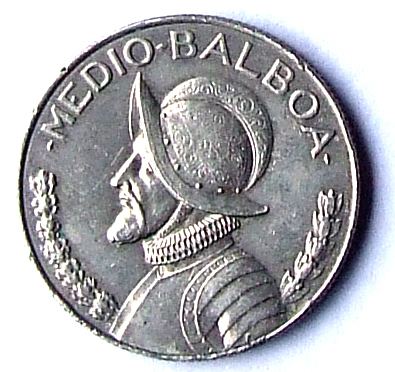⁄2 balboa(front) ⁄2 balboa(back) ⁄100 Centésimo | Code PAB Symbol B/. | |
 | ||
Banknotes None (U.S. dollars are employed instead, although denominated in balboas) Coins 1 & 5 centésimos, ⁄10, ⁄4, ⁄2, and 1 balboas | ||
The balboa (sign: B/.; ISO 4217: PAB) is, along with the United States dollar, one of the official currencies of Panama. It is named in honor of the Spanish explorer/conquistador Vasco Núñez de Balboa. The balboa is subdivided into 100 centésimos.
Contents
The history of the Panamanian balboa
The balboa replaced the Colombian peso in 1904 following the country's independence. The balboa has been tied to the United States dollar (which is also a legal tender in Panama) at an exchange rate of 1:1 since its introduction and has always circulated alongside dollars.
Coins
In 1904, silver coins in denominations of 2 1⁄2, 5, 10, 25, and 50 centésimos were introduced. These coins were weight-related to the 25 gram 50 centésimos, making the 2 1⁄2 centésimos coin 1 1⁄4 grams. Its small size led to it being known as the "Panama pill" or the "Panama pearl". In 1907, copper-nickel 1⁄2 and 2 1⁄2 centésimos coins were introduced, followed by copper-nickel 5 centésimos in 1929. In 1930, coins for 1⁄10, 1⁄4, and 1⁄2 balboa were introduced, followed by 1 balboa in 1931, which were identical in size and composition to the corresponding U.S. coins. In 1935, bronze 1 centésimo coins were introduced, with 1 1⁄4 centésimo pieces minted in 1940.
In 1966, Panama followed the U.S. in changing the composition of their silver coins, with copper-nickel clad 1⁄10 and 1⁄4 balboa, and .400 fineness 1⁄2 balboa. 1 balboa coins, at .900 fineness silver, were issued that year for the first time since 1947. In 1973, copper-nickel clad 1⁄2 balboa coins were introduced. 1973 also saw the revival of the 2 1⁄2 centésimos coin, which had a size similar to that of the U.S. half dime, but these were discontinued two years later due to lack of popular demand. In 1983, 1 centésimo coins followed their U.S. counterpart by switching from copper to copper plated zinc. Further issues of the 1 balboa coins have been made since 1982 in copper-nickel without reducing the size.
Modern 1 and 5 centésimos and 1⁄10, 1⁄4, and 1⁄2 balboa coins are the same weight, dimensions, and composition as the U.S. cent, nickel, dime, quarter, and half-dollar, respectively. In 2011, new 1 and 2 balboa bimetallic coins were issued.
In addition to the circulating issues, commemorative coins with denominations of 5, 10, 20, 50, 75, 100, 150, 200, and 500 balboas have been issued.
